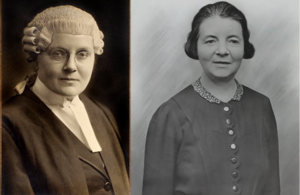Legal firsts
How women achieved legal firsts following the Sex Disqualification (Removal) Act 1919

Helena Normanton KC and Carrie Morrison
The Sex Disqualification (Removal) Act 1919 received Royal Assent on the 23 December 1919 and marked an important step forward in women’s rights. The Act removed barriers to women being allowed to enter the legal profession, sit on juries, and become civil servants.
In 1903 Bertha Cave applied to become a member of Gray’s Inn. However, her application was refused by the Pension committee on the basis of her sex and the opinion that only men could be admitted as students. She appealed but was ultimately rejected. Despite the rejections, Bertha’s bravery can be viewed as an important moment in women’s fight to be permitted to practice as barristers and solicitors, ultimately leading to the Sex Disqualification (Removal) Act 1919 and the Equal Franchise Act of 1928 that gave the right to vote to all women above the age of 21.
Helena Normanton KC became the first woman to join one of the four Inns of Court, joining Inner Temple on Christmas Eve 1924. She would become the first woman to practice in England and Wales and the second woman to be called to the Bar, following Dr Ivy Williams in May 1922. In 1949, along with Rose Heilbron, she became the first woman to take silk.
Her lifelong commitment to equal rights and women’s suffrage paved the way for all women in law who succeeded her.
She was the first woman to obtain a divorce for her client and the first female counsel to appear in the High Court and The Old Bailey.
In 1924, she became the first married woman to obtain a passport in her maiden name.
Having been orphaned at an early age, she attributed much of her success to the University of Sussex. She left the university a gift in her will, after which the university recognised her as a founding funder. In 2015, the university erected a plaque on campus to celebrate her lifelong commitment to the intersection of law and feminism.
Carrie Morrison was the first woman to be admitted to the roll of solicitors in 1922 and she was followed closely by Maud Crofts, Mary Elizabeth Pickup and Mary Elaine Sykes in 1923.
She helped to pave the way for future generations and was regarded by her contemporaries as ‘the senior woman solicitor of England.’
A champion of women’s rights, Morrison refused to use her married surname and successfully petitioned the President of the Probate, Divorce and Admiralty Division to be permitted to use a professional rather than a marital status descriptor in official documents.
Over 100 years later women now represent over half of all government lawyers, and GLD’s Permanent Secretary and Treasury Solicitor Susanna McGibbon is supported by Directors General Mel Nebhrajani CB, Sarah Goom and Caroline Croft.
Updates to this page
Last updated 18 December 2023 + show all updates
-
Summary updated.
-
First published.